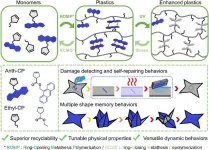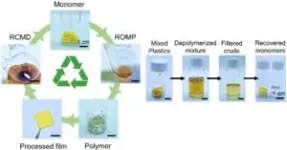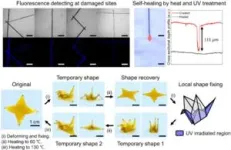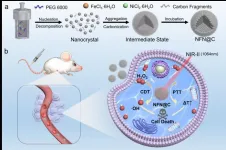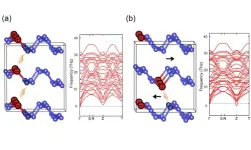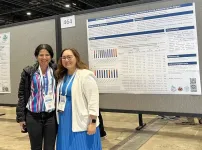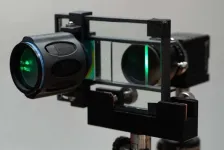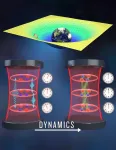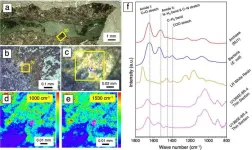(Press-News.org) Plastics, which are polymeric materials composed of long chains of small molecules called monomers, are widely used in everyday life and industry due to their lightweight, good strength and flexibility. However, with approximately 52 million tons of plastic waste generated annually, plastic pollution has become a major environmental concern. To address this issue, research efforts have focused on developing sustainable polymeric materials. Unfortunately, most materials developed so far suffer from complex synthesis processes or difficulties in separating them from other polymers during waste disposal.
To overcome these limitations, a research team led by Dr. Tae Ann Kim of the Convergence Research Center for Solutions to Electromagnetic Interference in Future-mobility (SEIF) at Korea Institute of Science and Technology (KIST) has developed a new polymeric material with self-healing capabilities and high recyclability. The team designed a unique pentagonal ring-structured molecule that can not only be freely converted between monomers and polymers but also facilitates dynamic covalent exchange reactions in response to heat, light, and mechanical forces. This molecule enables creating polymeric materials with a wide range of properties, as flexible as a rubber band or as rigid as a glass bottle.
The newly developed polymer is easy to manage, as it exhibits fluorescence at damaged sites, enabling real-time damage detection, and self-heals when exposed to heat and light. Upon disposal, this material can selectively depolymerize into its monomers, even when mixed with conventional plastics. The recovered monomers can then be used to regenerate polymers that retain their original properties. These features present an innovative solution for enhancing both sustainability and recyclability of polymeric materials.
Beyond its recyclability, this material dynamically change its thermal, mechanical, and optical properties in response to heat, light, and mechanical forces. When used as a protective coating, it demonstrates outstanding performance, with a hardness up to three times and an elastic modulus more than two times higher than conventional epoxy coatings. Additionally, exposure to ultraviolet light strengthens molecular interactions, enabling the material to fix specific shapes. This shape memory capability opens up potential applications in smart clothing, wearable devices, and advanced robotics.
With its high mechanical strength, damage resistance, self-healing, damage detection, and selective recyclability, this polymeric material presents a promising solution to reduce economic costs associated with sorting and processing mixed plastic waste. Furthermore, by replacing industrial coatings with this eco-friendly alternative, the maintenance costs of coating can be significantly reduced while mitigating environmental pollution.
Dr. Tae Ann Kim, a principal researcher of the Soft Materials Research Group, emphasized, "This research introduces a new approach to designing materials with autonomous functionalities, such as damage detection and self-healing, while overcoming the thermal and mechanical limitations of recyclable plastics derived from pentagonal ring monomers" He further added, "We are striving to pioneer the market for eco-friendly functional coatings that require minimal maintenance and generate no waste."
###
KIST was established in 1966 as the first government-funded research institute in Korea. KIST now strives to solve national and social challenges and secure growth engines through leading and innovative research. For more information, please visit KIST’s website at https://eng.kist.re.kr/
This research was supported by the National Research Council of Science and Technology (NST) grant (CRC22033-230) of the Ministry of Science and ICT (Minister Sang-im Yoo) and the Nano & Material Technology Development program (RS-2024-00448445) of the National Research Foundation of Korea. The research was published in the latest issue of Advanced Functional Materials, a leading international journal in materials science (IF 18.5, JCR top 4.329%).
END
Developing zero-waste, sustainable smart polymer materials
Shape memory materials that change color upon damage and self-repair
2025-03-06
ELSE PRESS RELEASES FROM THIS DATE:
AI has ‘great potential’ for detecting wildfires, new study of the Amazon rainforest suggests
2025-03-06
A type of Artificial Intelligence that mimics the functioning of the human brain could represent a powerful solution in automatically detecting wildfires, plummeting the time needed to mitigate their devastating effects, a new study finds.
The new technology uses an ‘Artificial Neural Networks’ model that combines satellite imaging technology with deep learning (a subset of Artificial Intelligence (AI) and machine learning).
Findings, published in the peer-reviewed International Journal of Remote Sensing, report a 93% success rate when training the model via a dataset ...
Magnetic catalysts enhance tumor treatment via electronic density regulation
2025-03-06
Recently, a collaborative research team led by Professor WANG Hui and Professor ZHANG Xin from the Hefei Institutes of Physical Science of the Chinese Academy of Sciences, successfully developed a novel carbon-coated nickel ferrite (NFN@C) nanocatalyst with significant potential in cancer therapy.
The results have been published in Advanced Functional Materials.
Cancer therapy has always struggled with targeting tumor cells effectively while minimizing damage to healthy tissue. Traditional treatments like chemotherapy and radiation often have limited precision and serious side effects. This has led to increased ...
Quantum dot discovery for LEDs brings brighter, more eco-friendly displays
2025-03-06
New research by Curtin University has achieved a breakthrough in eco-friendly display technology, creating highly efficient and stable blue quantum dot LEDs (QLEDs) that could power the next generation of televisions, smartphones, VR headsets and energy-efficient lighting - without using toxic heavy metals.
Study author Associate Professor Guohua Jia from Curtin’s School of Molecular and Life Sciences said QLEDs are a futuristic display technology known for their superior brightness, colour accuracy, lifetime and energy efficiency compared to traditional LEDs. However, creating stable and efficient blue QLEDs without toxic materials ...
Phosphorus doping stabilizes high-energy polymeric nitrogen at ambient pressure
2025-03-06
Using first-principles calculations, a research group led by Prof. WANG Xianlong from the Hefei Institutes of Physical Science of the Chinese Academy of Sciences, found that phosphorus doping is an effective way to achieve high-energy polymeric nitrogen with black-phosphorus structure (BP-N) stable at ambient pressure.
The research results were published in Matter and Radiation at Extremes.
Cubic gauche nitrogen with diamond-like structure and BP-N with black phosphorus structure, represented by polymeric all-nitrogen materials, are a class of high-energy density materials composed entirely of N-N single bonds, but their samples ...
Maternal cannabis use triples risk of disruptive behaviour in children
2025-03-06
Children exposed to their mother’s cannabis use during pregnancy and after birth are three times more likely to develop behavioural problems, new Curtin University research has found.
Published in Psychiatry Research, the study analysed data from more than 222,600 Australian mothers and children, revealing maternal cannabis use disorder (CUD) during pregnancy and the postnatal period significantly increased the risk of childhood disruptive behavioural disorders.
Lead researcher Abay Tadesse, from Curtin’s School of Population ...
Balancing Nutrition: Micronutrient study could help prevent childhood obesity in Pacific region
2025-03-06
Children ages two to eight years across 11 Pacific jurisdictions (Alaska, American Samoa, Commonwealth of the Northern Mariana Islands, Federated States of Micronesia, Guam, Hawai‘i, Marshall Islands, and Palau) are not meeting daily recommended intakes for key micronutrients, either consuming too much or too little. That discovery was published recently in a study led by scientists at the University of Hawai‘i (UH) at Mānoa. The research team also found associations between children’s micronutrient intake, obesity, and presence of acanthosis nigricans, a skin condition that is ...
Lightening the load of augmented reality glasses
2025-03-06
An international team of scientists developed augmented reality glasses with technology to receive images beamed from a projector, to resolve some of the existing limitations of such glasses, such as their weight and bulk. The team’s research is being presented at the IEEE VR conference in Saint-Malo, France, in March 2025.
Augmented reality (AR) technology, which overlays digital information and virtual objects on an image of the real world viewed through a device’s viewfinder or electronic display, has gained traction in recent years with popular gaming apps like Pokémon Go, and real-world applications in areas including education, manufacturing, ...
Sneaky clocks: uncovering Einstein’s relativity in an interacting atomic playground
2025-03-06
For over a century, physicists have grappled with one of the most profound questions in science: How do the rules of quantum mechanics, which govern the smallest particles, fit with the laws of general relativity, which describe the universe on the largest scales?
The optical lattice clock, one of the most precise timekeeping devices, is becoming a powerful tool used to tackle this great challenge. Within an optical lattice clock, atoms are trapped in a “lattice” potential formed by laser beams and are manipulated with precise control of quantum coherence and interactions governed by quantum mechanics. Simultaneously, ...
The chances of anything coming from Mars
2025-03-06
Within the next decade, space agencies plan to bring samples of rock from Mars to Earth for study. Of concern is the possibility these samples contain life, which could have unforeseen consequences. Therefore, researchers in this field strive to create methods to detect life. For the first time, researchers, including those from the University of Tokyo and NASA, successfully demonstrated a method to detect life in ancient rocks analogous to those found on Mars.
We’ve all seen the movies, in which “Scientists bring back something from space, ...
Scientists unlock clues to new treatments for muscular dystrophy
2025-03-06
A new discovery about how tiny protein clusters form in cells could pave the way for treatments for Emery-Dreifuss muscular dystrophy (EDMD), a rare genetic disorder that causes muscle weakness and heart problems.
Researchers at the USC Dornsife College of Letters, Arts and Sciences combined advanced imaging techniques and theoretical physics to observe and explain how nanoclusters of the protein emerin form inside living cells. These clusters — about 100,000 times smaller than a human hair’s width — play a crucial role in how cells sense and respond to mechanical forces like stretching or pressure, ...
LAST 30 PRESS RELEASES:
Signature patterns of brain activity may help predict recovery from traumatic brain injury
Dresden study uncovers new key mechanism in cancer cells
New species are now being discovered faster than ever before, study suggests
Cannabis-based products show limited short-term benefit for chronic pain, with increased risk of adverse effects
Cannabis products with more THC slightly reduce pain but cause more side effects
Clearing the brain of aging cells could aid epilepsy and reduce seizures
Brain injuries linked with potential risk of suicide, new study finds
New technique lights up where drugs go in the body, cell by cell
New study finds movement of fishing fleets can reveal shifts in marine ecosystems
Embargoed: New evidence points to potential treatment for vascular dementia
Study uncovers disrupted brain balance in alcohol dependence
Working in groups can help Republicans and Democrats agree on controversial content moderation online
Structural findings reveal how distinct GPCR ligands create different levels of activation
Anything-goes “anyons” may be at the root of surprising quantum experiments
UC review: Maximizing workplace opportunity for veterans
From generation to complex control: Metasurfaces make perfect vortex beams "within reach"
Thin-film lithium niobate-based detector: recent advances and perspectives
Exploring why some people may tend to persistently make bad choices
How cells balance their protein levels
Nirsevimab vs RSVpreF vaccine for RSV–related hospitalization in newborns
Effectiveness and impact of maternal RSV immunization and nirsevimab on medically attended RSV in US children
AI gives scientists a boost, but at the cost of too many mediocre papers
Next-generation vision model maps tree growth at sub-meter precision
Genes aren’t destiny for inherited blindness, study shows
MIT study: High-fat diets make liver cells more likely to become cancerous
Exposure to multiple fine particulate matter components and incident depression in the US Medicare population
Risk of burdensome health care spending over time in the US
Nirsevimab against hospitalizations and emergency department visits for lower respiratory tract infection in infants
New microfluidics technology enables highly uniform DNA condensate formation
A new strategy for immune tolerance
[Press-News.org] Developing zero-waste, sustainable smart polymer materialsShape memory materials that change color upon damage and self-repair
